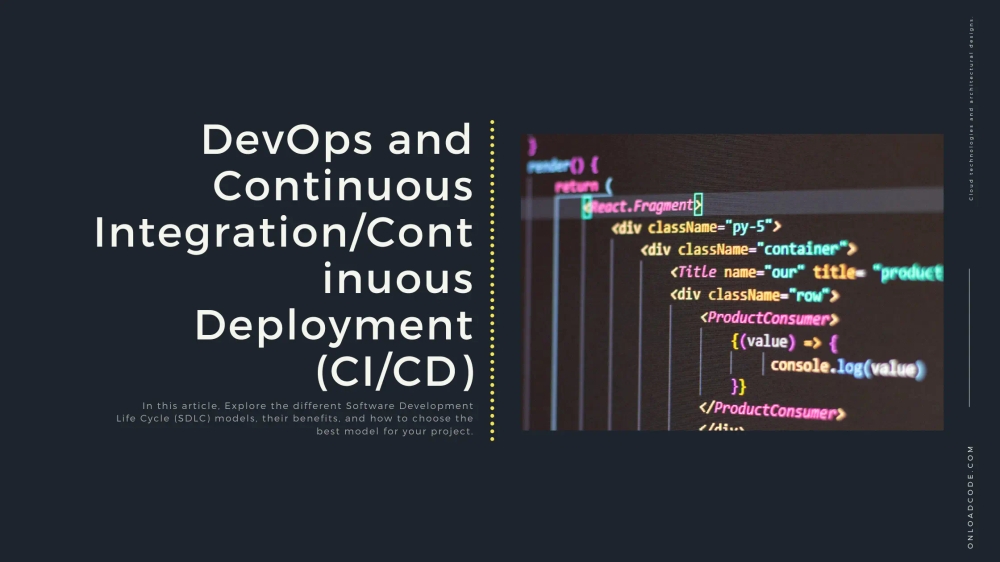Published
- 3 min read
DevOps and Continuous Integration/Continuous Deployment (CI/CD)

DevOps and Continuous Integration/Continuous Deployment (CI/CD)
Introduction
DevOps is a software development approach that integrates development (Dev) and operations (Ops) teams to improve collaboration, automate workflows, and accelerate software delivery. Continuous Integration/Continuous Deployment (CI/CD) is a crucial aspect of DevOps, enabling frequent code integration, automated testing, and rapid deployment.
What is DevOps?
DevOps is a cultural shift that breaks down silos between development and operations teams. It focuses on automation, monitoring, and continuous feedback to deliver high-quality software faster. DevOps practices include:
- Collaboration: Developers and operations teams work closely together.
- Automation: Tasks like testing, deployment, and monitoring are automated.
- Continuous Integration (CI): Frequent code commits and automated builds ensure code quality.
- Continuous Deployment (CD): Automated deployment processes ensure quick releases.
- Monitoring and Feedback: Real-time tracking of application performance and security.
Benefits of DevOps
- Faster Development Cycles: Reduces the time from development to deployment.
- Improved Collaboration: Enhances teamwork between developers, testers, and operations teams.
- Increased Deployment Frequency: Enables multiple releases per day instead of weeks or months.
- Better Quality Software: Automated testing ensures fewer bugs and higher stability.
- Enhanced Security: Integrating security checks early in the pipeline (DevSecOps).
- Cost Efficiency: Reduces manual effort and infrastructure costs.
What is CI/CD?
CI/CD is a set of DevOps practices that automate software development, testing, and deployment. The goal is to minimize manual intervention and ensure that high-quality code is deployed efficiently.
Continuous Integration (CI)
- Developers frequently merge their code changes into a shared repository.
- Automated builds and tests run on every commit.
- Detects and resolves issues early in development.
Continuous Deployment (CD)
- Automates the process of deploying tested code into production.
- Reduces deployment failures and rollbacks.
- Ensures quick and reliable software releases.
CI/CD Pipeline Stages
| Stage | Description |
|---|---|
| Code | Developers write and commit code to a version control system (e.g., Git). |
| Build | The code is compiled, dependencies are installed, and an executable is created. |
| Test | Automated unit, integration, and functional tests are run to validate the build. |
| Release | The build is packaged and prepared for deployment. |
| Deploy | The software is deployed to staging or production environments. |
| Monitor | Application performance, logs, and user feedback are monitored to identify issues. |
CI/CD Tools
Several tools are available for implementing CI/CD pipelines:
- Version Control: Git, GitHub, GitLab, Bitbucket
- Build Automation: Jenkins, GitHub Actions, CircleCI, GitLab CI/CD
- Testing: Selenium, JUnit, Jest, PyTest
- Deployment: Kubernetes, Docker, Ansible, Terraform
- Monitoring: Prometheus, Grafana, ELK Stack
Comparison: DevOps vs. Traditional Development
| Feature | Traditional Development | DevOps |
|---|---|---|
| Speed | Slow releases (weeks/months) | Frequent releases (daily/weekly) |
| Automation | Manual testing & deployment | Automated testing & deployment |
| Collaboration | Separate dev & ops teams | Unified dev & ops teams |
| Flexibility | Fixed release cycles | Agile & adaptive release cycles |
| Monitoring | Minimal monitoring | Continuous real-time monitoring |
Best Practices for Implementing DevOps and CI/CD
- Start Small: Begin with a small CI/CD pipeline and gradually expand automation.
- Use Infrastructure as Code (IaC): Automate infrastructure provisioning with tools like Terraform.
- Adopt Microservices: Break monolithic applications into smaller, independent services.
- Monitor Everything: Use logging and monitoring tools to track application performance.
- Implement Security Early (DevSecOps): Integrate security checks into the CI/CD pipeline.
- Encourage Collaboration: Promote teamwork between developers, testers, and operations teams.
Conclusion
DevOps and CI/CD revolutionize software development by automating processes, improving collaboration, and enabling rapid software delivery. By implementing DevOps best practices and a robust CI/CD pipeline, teams can achieve higher efficiency, better software quality, and faster time to market.
Quiz Questions
- What are the key benefits of DevOps?
- What is the main difference between Continuous Integration and Continuous Deployment?
- Name three popular CI/CD tools used in software development.
- How does DevOps improve collaboration between teams?
- Why is monitoring an essential part of CI/CD?
- What is Infrastructure as Code (IaC) and why is it important in DevOps?
- How does DevSecOps integrate security into the CI/CD pipeline?
